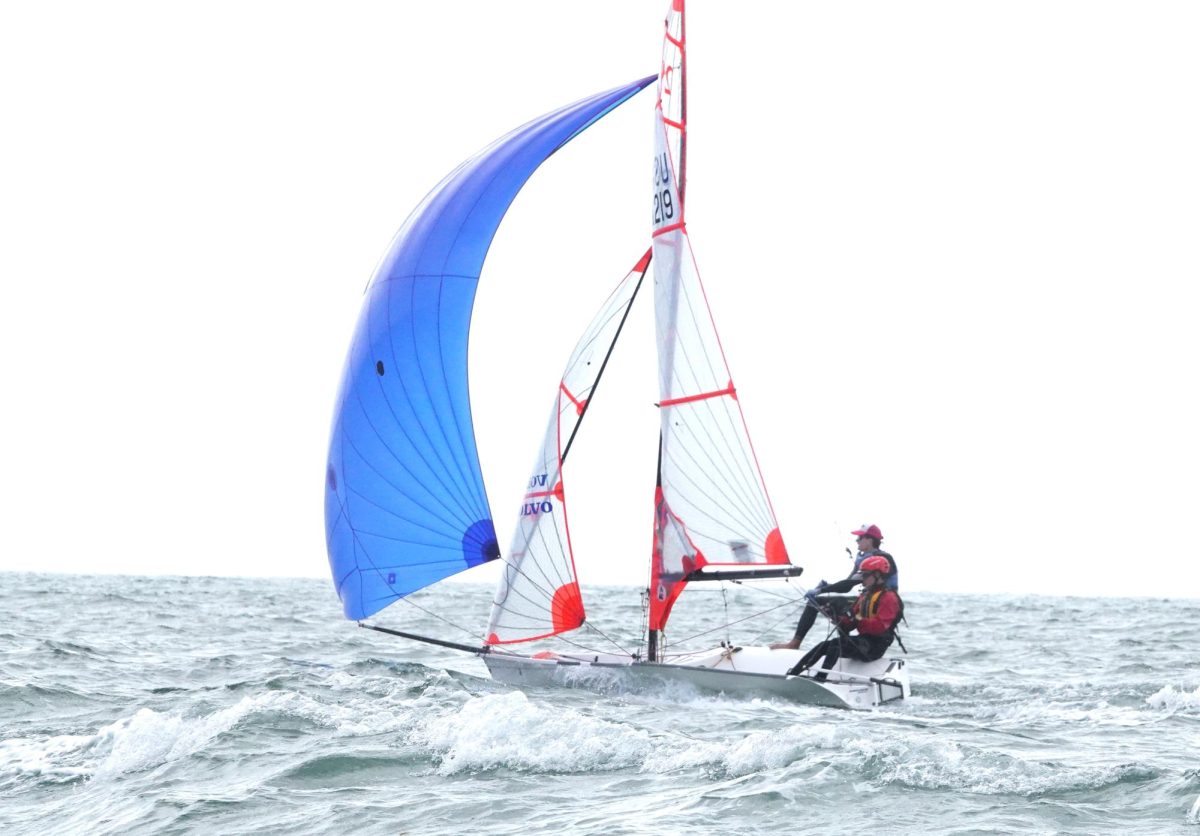With the sea breeze whipping through his hair and the ocean spraying up against his face, junior Lorenzo Maino braces his feet on the side of his two-person boat and leans out backwards over the glistening water. The sails flap in the wind in front of him, and he shouts to his partner to adjust course.
On the San Francisco Bay, a small number of Paly students like Maino are setting out to sea. Coming from multiple sailing organizations around the San Francisco Bay, the small sport is slowly growing, though for the few Paly students who currently participate, it is making a large impact on their daily life.
Maino said he started sailing in second grade after his dad, a former sailor, encouraged him to pick up the sport. Since then, he has been sailing competitively and is training in Marin County at the San Francisco Yacht Club. He sails a 29er dinghy, a small swift sailboat which fits two people. Maino said each partner has different responsibilities, with one directing the boat while the other controlls the speed.
“My partner is the driver who is steering and he has the jib or front sail,” Maino said. “That basically acts like a gearbox in a car. I have the mainsail, which is the power, so I’m hanging off on a harness, out off the side of the boat, controlling the speed.”
Maino said the process requires focus, as both partners are expected to be in sync with one another to make perfect turns at high speeds.
“You’ve got to really get in tune with your partner,” Maino said. “If one person moves, the boat moves and the other person moves too. You’re physically connected.”
Maino competes in sailing competitions, called regattas, which are day-long events consisting of multiple races, each lasting around 30 minutes. Maino said the races consist of specific routes that sailors have to navigate their boat through multiple times.
“It’s kind of like golf where each race you get a score, which is based on your (final) position,” Maino said. “Your total score is the combination of all those. The lowest score wins the entire event.”
Maino also said it is a common misconception that sailing is an expensive sport.
“Most clubs will let you use their boats for free as long as you are part of the team, which you pay to be on for coaching,” Maino said. “We usually put the boats on a trailer to bring them around locally, which (the club) does for you, so for the most part, it’s a pretty affordable sport.”
Junior Kashi Tuteja, who started sailing at the beginning of his freshman year, joins eight other registered Paly students at the Redwood City-based Peninsula Youth Sailing Foundation each week, coached by Olympian sailor Molly O’Brian Vandemoer. He said learning sailing is difficult due to the lack of exposure.
“For a lot of people out there, if they want to do a sport in high school, I don’t think sailing is the first thing that comes to mind,” Tuteja said. “It definitely wasn’t the first thing that came to my mind. So you have to get into it in some way. But if you’re interested in trying out a water sport, checking out some summer camps is a great way to (get started).”
Freshman Mira Stettner, who sails at PYSF alongside Tuteja, said she started sailing in second grade after signing up for a summer camp. She started sailing competitively in seventh grade and has similarly felt there is a lack of knowledge about the sport.
“When I tell people I do sailing, they’re like, ‘Oh you do rowing?’” Stettner said. “It’s such a niche sport.”
Stettner sails two different types of boats, the FJ and the 420, which are common at the high school level and require a two-person team to sail. FJs are typically more maneuverable and tippy in the water due to their rounder hulls, while 420s are slightly wider and perform better in strong wind. Additionally, FJs lack the trapeze, which is a harness that allows sailors to lean out of the boat. However, Stettner said it is easy to switch between the two.
“Most skills transfer over, whether you’re doing big boats or really small boats,” Stettner said. “It’s the same sport and the same game. You just have to learn about the technicalities for each boat.”
And Stettner said the sport is rewarding.
“I’ve made so many friends just from having them in my boat,” Stettner said. “There’s teamwork, but (sailing) can also be solo and independent. It’s both mental and physical.”
However, practice can also be intense. Maino said he practices on the weekends for six hours each day off the coast of Marin.
“We usually have our coach give us a simple route or we practice boat speed,” Maino said. “Then you talk to other boats to see what they’re doing and compare what you’re doing.”
There are multiple high level competitions for youth sailors across the country, such as the annual summer Nationals tournament. Maino said the competition is fierce at the national level.
“I went to nationals this summer and youth champs,” Maino said. “Only one team qualifies to Worlds out of 30-40 29er teams, but if you race 420s, there were like 200 (teams). And for high school, it’s even more crazy.”
In the midst of the competition season, Stettner said she and her partner are currently preparing for the Midwinters regatta in Florida.
“It’s a three day race, and it’s super big, and I’m nervous because the Florida sailors are really good,” Stettner said. “So hopefully me and my partner can do OK, but we’ll see.”
But even before the race starts, Maino said competition is intense. Sailors have to race to get to the starting line, so they often use a complex system of “right of way” rules to determine which boat can go first in order to avoid collisions.
“You want to use your right (of way) to get into a better position, which will allow you to go faster,” Maino said. “You want to end up starting at full speed crossing the start line, kind of like a rolling start in cars.”
Stettner said she enjoys the unpredictability of the weather conditions that sailing relies so heavily on, requiring sailors to concentrate to be able to change their strategies at a whim.
“I like how conditions are always changing,” Stettner said. “You could either have a super high energy, windy day and you’re going super fast and it’s super awesome, or you could just be out there relaxing, hanging out with your friends.”
Most importantly, Tuteja said sailing brings him joy when he’s on the water.
“It’s really exhilarating because you’re going very fast along the water,” Tuteja said. “You get to spend time with the wind and the rain … The opportunity to both get to do a fast moving, very exciting sport and get to do it against other people is a lot of fun.”




